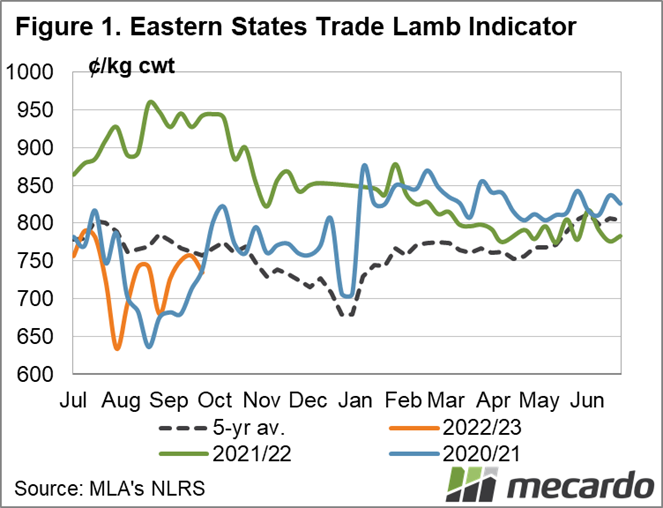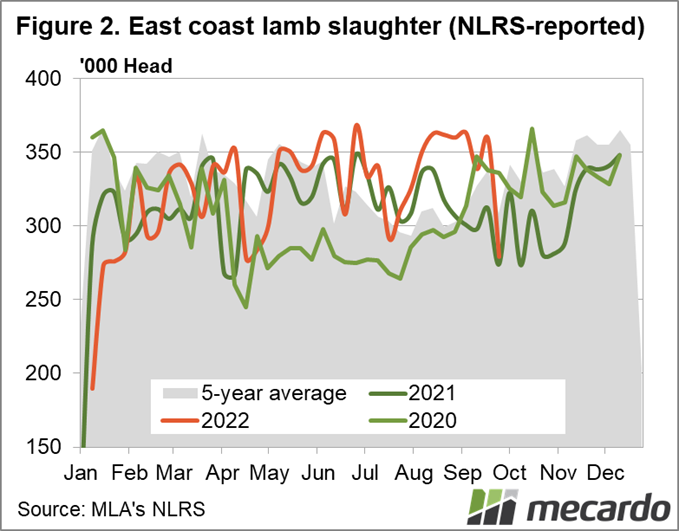We’ve hit the second month of spring, and the public holidays have come and gone, so it should be time for lamb numbers, and prices, to hit some sort of rhythm. New season lambs are about six weeks later to the party than usual, as was expected, but they’ve started to overtake old lambs in the yards. This week’s forecasted falls across many sheep producing parts of the country could impact supply yet again, but let’s see how things are faring so far for lamb this spring.
Starting with Figure 1, the Eastern States Trade Lamb Indicator’s average last week was 737ȼ/kg, nearly 30ȼ/kg below the five-year-average and a fairly significant discount of more than 200ȼ/kg – or 22% – on last year. That week last year was when the ESTLI was at its fourth highest recorded weekly average ever of 944ȼ/kg. And to put it into historical perspective, last week’s ESTLI was still the fourth highest price ever recorded for that particular week, and it was more than 100ȼ/kg above the 10-year-average. So down, but definitely not out. Over-the-hooks, the last report available has the medium trade lamb price at 693ȼ/kg as of the start of September.
East coast lamb slaughter (Figure 2) gives some insight into downward price pressure, with slaughter trending above both year-ago levels and the five-year average since May (disregarding the most recent figures impacted by public holiday closures). Total lamb slaughter for the 10 weeks prior was 8% higher than for the same period last year, with an extra 272,000 head processed. For 2022 so far, the average weekly lamb slaughter has been trending at about 4% higher than 2021.
The Meat and Livestock Australia and Australian Wool Innovation producer survey tells us that as of June 30 there were close to 7.6 million lambs expected to be sold in the following four months. Of these, 23% were pure meat breed lambs. If we compare this to the June 2021 survey, there were 7.2 million lambs to be sold in the four months after June 30, with only 17% pure meat breed lambs. In actual figures of meat lambs, it was 1.25 million in the June 2021 survey, and 1.75 million in this year – an extra half a million lambs.
The latest market comment from AuctionsPlus has new season lambs making up 57% of their commercial sheep and lamb sales last week, and total offerings up 14% on the previous week. According to MLA’s trade lamb indicator breakdown, new season lambs made up between 50 and 68% of the daily eligible lambs last week – showing they were the majority, but there were still plenty of old lambs about.
What does it mean?
It comes as no surprise that new season lambs are hitting the market late, and that now they have started to roll in there are plenty about. While lamb throughput has tracked ahead of last year, the figures show there’s still about a predicted 230,000 extra meat lambs expected to be sold before the end of this month that have yet to be slaughtered. Prices, while still historically stable, have fallen significantly from the past few years of record highs. New season quality might bump up competition between processors, but supply is likely to soon override this and keep the price trajectory headed south as lambs to start coming in numbers.
Have any questions or comments?
Key Points
- Eastern States Trade Lamb Indicator is 22% lower year-on-year as new season lambs begin to make up a majority of saleyard throughput.
- Lamb slaughter for the past 10 weeks is up 8% year-on-year, with average weekly lamb slaughter trending at about 4% higher for 2022.
- Lamb supply all set to significantly ramp up if weather allows.
Click on figure to expand
Click on figure to expand
Data sources: MLA, Mecardo














